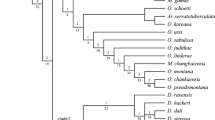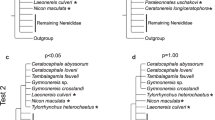Abstract
The family Eupodidae is one of eight families belonging to the superfamily Eupodoidea. Although the Eupodidae are very common mites, they are still poorly investigated and the systematic parameters of the family are vague with unclear intrafamilial relationships between its genera. According to the hypothesis of Jesionowska (Genus 21(4):637–658, 2010), the eupodid genera Cocceupodes, Linopodes and her new genus Filieupodes should be transferred from the Eupodidae to a separate family named Cocceupodidae. The opposite hypothesis of Khaustov (ZooKeys 422:11–22, 2014) considers the family Cocceupodidae an artificial taxon and the genus Filieupodes a junior synonym of Cocceupodes and assignes the family Eupodidae its primary definition. Here, we present the first molecular reconstruction of phylogenetic relationships within the Eupodidae. We test the taxonomic status of the Eupodidae and refer to the previous hypotheses based on morphological data. According to the reconstructed phylogram based on nuclear (18S + 28S rDNA) and mitochondrial (COI) sequences as well as morphological characters tracing this analysis, we have concluded that: (1) the genera Linopodes, Filieupodes and Cocceupodes are a separate monophyletic lineage of familial rank and the sister group of Eupodidae s.s., and (2) the genus Filieupodes should be considered a separate genus being a sister group of the Linopodes-Cocceupodes clade.




Similar content being viewed by others
References
Abou-Awad BA (1984) The Eupodid mites of Egypt (Acari, Eupodoidea, Eupodidae). Acarologia 25(4):329–335
Abou-Awad BA, El-Bagoury ME (1984) Two new species of genus Cocceupodes in Egypt (Acari: Eupodoidea: Eupodidae). Bull Zool Soc Egypt 34:68–75
Baker (1987) Caleupodes, a new genus of eupodoid mite (Acari: Acariformes) showing primary opisthosomal segmentation. Bull Br Museum (Nat Hist) 53:103–113. https://doi.org/10.5962/bhl.part.4952
Baker AS (1990) A survey of external morphology of mites of the superfamily Eupodoidea Banks, 1894 (Acari: Acariformes). J Nat Hist 24:1227–1261. https://doi.org/10.1080/00222939000770741
Baker AS, Lindquist EE (2002) Aethosolenia laselvensis gen. n., sp. n., a new eupodoid mite from Costa Rica (Acari: Prostigmata). Syst Appl Acarol Spec Publ 11:1–11. https://doi.org/10.11158/saasp.11.1.1
Dabert J, Ehrnsberger R, Dabert M (2008) Glaucalges tytonis sp. n. (Analgoidea, Xolalgidae) from the barn owl Tyto alba (Strigiformes, Tytonidae): compiling morphology with DNA barcode data for taxon descriptions in mites (Acari). Zootaxa 1719:41–52. https://doi.org/10.5281/zenodo.181058
Dabert M, Witalinski W, Kazmierski A, Olszanowski Z, Dabert J (2010) Molecular phylogeny of acariform mites (Acari, Arachnida): Strong conflict between phylogenetic signal and long-branch attraction artifacts. Mol Phylogenet Evol 56:222–241. https://doi.org/10.1016/j.ympev.2009.12.020
Dabert M, Proctor H, Dabert J (2016) Higher-level molecular phylogeny of the water mites (Acariformes: Prostigmata: Parasitengonina: Hydrachnidiae). Mol Phylogenet Evol 101:75–90. https://doi.org/10.1016/j.ympev.2016.05.004
Darriba D, Taboada GL, Doallo R, Posada D (2012) jModelTest 2: more models, new heuristics and parallel computing. Nat Methods 9(8):772. https://doi.org/10.1038/nmeth.2109
Fain A (1958) Un nouvel Acarien Trombidiforme parasitant les fosses nasals d’un Serpent au Ruanda-Urundi. Rev Zool Bot Afr 57:177–183
Felsenstein J (1985) Confidence limits on phylogenies: an approach using the bootstrap. Evolution 39:783–791. https://doi.org/10.1111/j.1558-5646.1985.tb00420.x
Guindon S, Gascuel O (2003) A simple, fast and accurate method to estimate large phylogenies by maximum-likelihood. Syst Biol 52:696–704. https://doi.org/10.1080/10635150390235520
Hall TA (1999) BioEdit: a user-friendly biological sequence alignment editor and analysis program for Windows 95/98/NT. Nucleic Acids Symp Ser 41:95–98
Jesionowska K (2005) Morfologia Cocceupodes mollicellus Koch, 1838 (Actinotrichida, Actinedida, Eupodidae) z Polski. Acta Biologica 12:35–48. (Zeszyty Naukowe Uniwersytetu Szczecińskiego no 411, in Polish)
Jesionowska K (2010) Cocceupodidae, a new family of eupodoid mites, with description of a new genus and two new species from Poland. Part I. (Acari: Prostigmata: Eupodoidea). Genus 21(4):637–658
Katoh K, Standley DM (2013) MAFFT multiple sequence alignment software version 7: improvements in performance and usability. Mol Biol Evol 4:772–780. https://doi.org/10.1093/molbev/mst010
Khaustov AA (2014) A new genus and species in the mite family Eupodidae (Acari, Eupodoidea) from Crimea. ZooKeys 422:11–22. https://doi.org/10.3897/zookeys.422.7802
Khaustov AA (2016) Rediagnosis of the genus Niveupodes Barilo, 1991 (Acari: Eupodidae) with the redescription of Niveupodes niveus Barilo. Int J Acarol 42(5):258–264. https://doi.org/10.1080/01647954.2016.1183044
Khaustov A (2017) A new genus and species of Eupodidae (Acari: Eupodoidea) from mosses in Crimea. Acarina 25(1):29–44. https://doi.org/10.21684/0132-8077-2017-25-1-29-44
Klimov BP, OConnor BM, Chetverikov PE, Bolton SJ, Pepato AR, Mortazavia AL, Tolstikov AV, Bauchan GR, Ochoa R (2018) Comprehensive phylogeny of acariform mites (Acariformes) provides insights on the origin of the four-legged mites (Eriophyoidea), a long branch. Mol Phylogenet Evol 119:105–117. https://doi.org/10.1016/j.ympev.2017.10.017
Lindquist EE, Zacharda M (1987) A new genus and species of Rhagidiidae (Acari: Prostigmata) from Chihuahuan Desert litter in New Mexico. Can J Zool 65:2149–2158
Maddison WP, Maddison DR (2014) Mesquite: a modular system for evolutionary analysis. Version 3.0. http://mesquiteproject.org. Accessed 16 June 2019
Mironov SV, Dabert J, Dabert M (2012) A new feather mite species of the genus Proctophyllodes Robin, 1877 (Astigmata: Proctophyllodidae) from the long-tailed tit Aegithalos caudatus (Passeriformes: Aegithalidae)-morphological description with DNA Barcode Data. Zootaxa 3253:54–61
Olivier PAS, Theron PD (1997) The genus Benoinyssus Fain (Acari: Eupodidae) from southern Africa, with descriptions of five new species Olivier. Afr Entomol 5(2):301–318
Olivier PAS, Theron PD (1998) The genus Eupodes Koch, 1835 (Acari: Prostigmata: Eupodidae) from southern African soil and vegetation. Part 1. Characterisation of the genus, designation of the type species and descriptions of three new species. Koedoe 40(1):57–73. https://doi.org/10.4102/koedoe.v40i2.273
Oudemans AC (1931) Acarologische aanteekeningen CVIII. Entomologische Berichten (Amsterdam) 8:251–263
Qin TK (1996) A review and cladistic analysis of the Eupodoidea (Acari: Acariformes). Syst Appl Acarol 1:77–105
Qin TK, Halliday B (1997) Eriorhynchidae, a new family of Prostigmata (Acarina), with a cladistics analysis of eupodoid species of Australia and New Zealand. Syst Entomol 22:151–171. https://doi.org/10.1046/j.1365-3113.1997.d01-27.x
Rambaut A (2014) FigTree v. 1.4.2. http://tree.bio.ed.ac.uk/software/figtree/. Accessed 16 August 2019
Rambaut A, Drummond AJ (2007) Tracer v1.4. http://beast.bio.ed.ac.uk/Tracer. Accessed 16 Aug 2019
Ronquist F, Teslenko M, van der Mark P, Ayres DL, Darling A, Höhna S, Larget B, Liu L, Suchard MA, Huelsenbeck JP (2012) MrBayes 3.2: efficient Bayesian phylogenetic inference and model choice across a large model space. Syst Biol 61:539–542. https://doi.org/10.1093/sysbio/sys029
Skoracka A, Dabert M (2009) The cereal rust mite Abacarus hystrix (Acari: Eriophyoidea) is a complex of species: evidence from mitochondrial and nuclear DNA sequences. Bull Entomol Res 100:263–272. https://doi.org/10.1017/S0007485309990216
Strandtmann RW, Goff ML (1978) The Eupodoidea of Hawaii (Acarina: Prostigmata). Pac Insects 19:121–143
Strandtmann RW, Prasse J (1977) Prostigmatic mites from the Experimental Farm in Etzdorf/Saalkreis, GDR. Abh Ber Naturkundemus Görlitz 50(2):1–33
Swofford DL (2003) PAUP*. Phylogenetic Analysis Using Parsimony (*and Other Methods). Version 4. Sinauer Associates, Sunderland
Telford MJ, Lockyer AE, Cartwright-Finch C, Littlewood DTJ (2003) Combined large and small subunit ribosomal RNA phylogenies support a basal position of the acoelomorph flatworms. Proc R Soc Lond [Biol] 270(1519):1077–1083. https://doi.org/10.1098/rspb.2003.2342
Walter DE, Lindquist EE, Smith IM, Cook DR, Krantz GW (2009) Order Trombidiformes. Chapter 13. In: Krantz GW, Walter DE (eds) A manual of acarology. Texas Tech University Press, Lubbock, pp 233–420
Zacharda M (1979) Strandtmanniidae—a new family of Eupodoidea (Acarina: Prostigmata). Věstník Československé společnosti zoologické 63:76–80
Zwickl DJ (2006) Genetic algorithm approaches for the phylogenetic analysis of large biological sequence data sets under the maximum likelihood criterion. Dissertation, The University of Texas, Austin
Acknowledgements
The funding for this work came from the National Science Centre—Poland, Grant #2014/13/B/NZ8/04679 (JD) and Dean's grant of Faculty of Biology, Adam Mickiewicz University, GDWB-04/2017 (NST).
Author information
Authors and Affiliations
Corresponding author
Additional information
Publisher’s Note
Springer Nature remains neutral with regard to jurisdictional claims in published maps and institutional affiliations.
Rights and permissions
About this article
Cite this article
Szudarek-Trepto, N., Kaźmierski, A., Dabert, M. et al. Molecular phylogeny of Eupodidae reveals that the family Cocceupodidae (Actinotrichida; Eupodoidea) and its genus Filieupodes are valid taxa. Exp Appl Acarol 80, 43–57 (2020). https://doi.org/10.1007/s10493-019-00455-4
Received:
Accepted:
Published:
Issue Date:
DOI: https://doi.org/10.1007/s10493-019-00455-4




